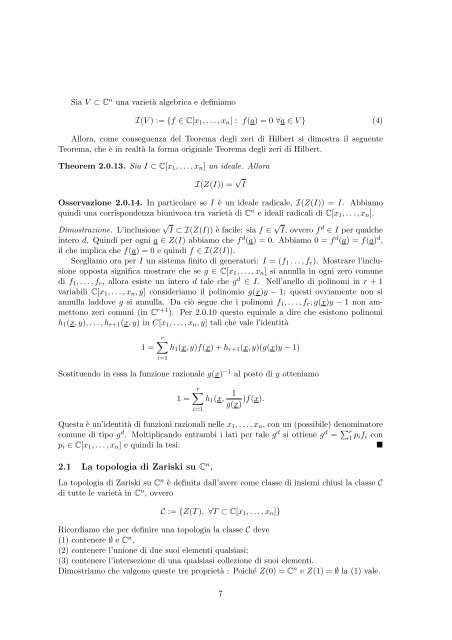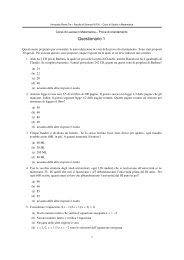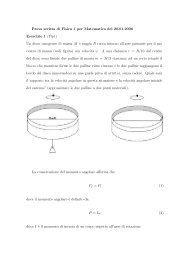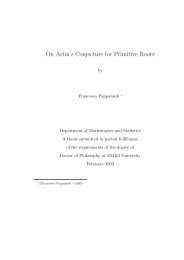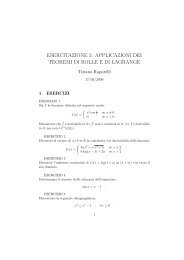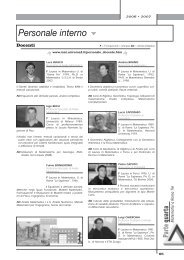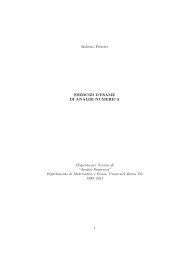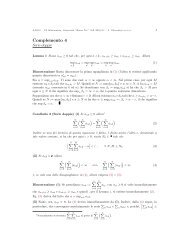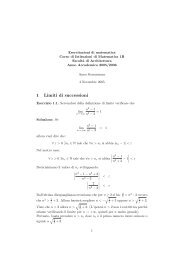Il Teorema degli zeri di Hilbert e la geometria algebrica
Il Teorema degli zeri di Hilbert e la geometria algebrica
Il Teorema degli zeri di Hilbert e la geometria algebrica
- No tags were found...
You also want an ePaper? Increase the reach of your titles
YUMPU automatically turns print PDFs into web optimized ePapers that Google loves.
Sia V ⊂ C n una varietà <strong>algebrica</strong> e definiamoI(V ) := {f ∈ C[x 1 , . . . , x n ] : f(a) = 0 ∀a ∈ V } (4)Allora, come conseguenza del <strong>Teorema</strong> <strong>degli</strong> <strong>zeri</strong> <strong>di</strong> <strong>Hilbert</strong> si <strong>di</strong>mostra il seguente<strong>Teorema</strong>, che è in realtà <strong>la</strong> forma originale <strong>Teorema</strong> <strong>degli</strong> <strong>zeri</strong> <strong>di</strong> <strong>Hilbert</strong>.Theorem 2.0.13. Sia I ⊂ C[x 1 , . . . , x n ] un ideale. AlloraI(Z(I)) = √ IOsservazione 2.0.14. In partico<strong>la</strong>re se I è un ideale ra<strong>di</strong>cale, I(Z(I)) = I. Abbiamoquin<strong>di</strong> una corrispondenza biunivoca tra varietà <strong>di</strong> C n e ideali ra<strong>di</strong>cali <strong>di</strong> C[x 1 , . . . , x n ].Dimostrazione. L’inclusione √ I ⊂ I(Z(I)) è facile: sia f ∈ √ I, ovvero f d ∈ I per qualcheintero d. Quin<strong>di</strong> per ogni a ∈ Z(I) abbiamo che f d (a) = 0. Abbiamo 0 = f d (a) = f(a) d ,il che implica che f(a) = 0 e quin<strong>di</strong> f ∈ I(Z(I)).Scegliamo ora per I un sistema finito <strong>di</strong> generatori: I = (f 1 . . . , f r ). Mostrare l’inclusioneopposta significa mostrare che se g ∈ C[x 1 , . . . , x n ] si annul<strong>la</strong> in ogni zero comune<strong>di</strong> f 1 , . . . , f r , allora esiste un intero d tale che g d ∈ I. Nell’anello <strong>di</strong> polinomi in r + 1variabili C[x 1 , . . . , x n , y] consideriamo il polinomio g(x)y − 1; questi ovviamente non siannul<strong>la</strong> <strong>la</strong>ddove g si annul<strong>la</strong>. Da ciò segue che i polinomi f 1 , . . . , f r , g(x)y − 1 non ammettono<strong>zeri</strong> comuni (in C r+1 ). Per 2.0.10 questo equivale a <strong>di</strong>re che esistono polinomih 1 (x, y), . . . , h r+1 (x, y) in C[x 1 , . . . , x n , y] tali che vale l’identità1 =r∑h 1 (x, y)f(x) + h r+1 (x, y)(g(x)y − 1)i=1Sostituendo in essa <strong>la</strong> funzione razionale g(x) −1 al posto <strong>di</strong> y otteniamo1 =r∑ 1h 1 (x,g(x) )f(x).i=1Questa è un’identità <strong>di</strong> funzioni razionali nelle x 1 , . . . , x n , con un (possibile) denominatorecomune <strong>di</strong> tipo g d . Moltiplicando entrambi i <strong>la</strong>ti per tale g d si ottiene g d = ∑ r1 p if i conp i ∈ C[x 1 , . . . , x n ] e quin<strong>di</strong> <strong>la</strong> tesi.2.1 La topologia <strong>di</strong> Zariski su C n .La topologia <strong>di</strong> Zariski su C n è definita dall’avere come c<strong>la</strong>sse <strong>di</strong> insiemi chiusi <strong>la</strong> c<strong>la</strong>sse C<strong>di</strong> tutte le varietà in C n , ovveroC := {Z(T ), ∀T ⊂ C[x 1 , . . . , x n ]}Ricor<strong>di</strong>amo che per definire una topologia <strong>la</strong> c<strong>la</strong>sse C deve(1) contenere ∅ e C n ,(2) contenere l’unione <strong>di</strong> due suoi elementi qualsiasi;(3) contenere l’intersezione <strong>di</strong> una qualsiasi collezione <strong>di</strong> suoi elementi.Dimostriamo che valgono queste tre proprietà : Poiché Z(0) = C n e Z(1) = ∅ <strong>la</strong> (1) vale.7


